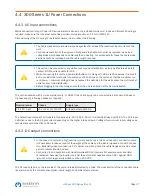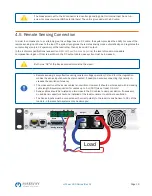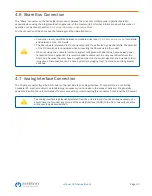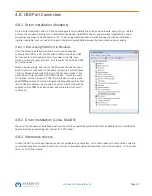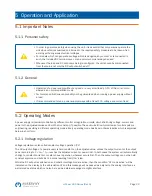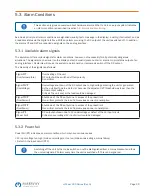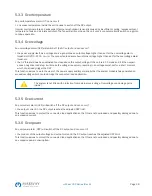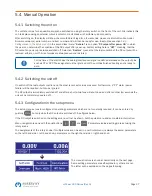
Page 14
mPower 300 Series (Rev G)
3.2.5 Ethernet port
The Ethernet port on the back of the unit is provided for remote control
and monitoring. The user has basically two options for access:
1. A website (HTTP, port 80) which is accessible in a standard browser
under the IP or the host name given to the unit. This website offers a
configuration page for network parameters, as well as a input box for
SCPI commands.
Share
Sense
NC NC
+ -
-
+
Analog Interface
USB
LAN
2. TCP/IP access via a configurable port (except 80 and other reserved ports). The standard port is 5025, default IP
is 192.168.0.2. Via TCP/IP and this port, communication to the system can be established in most of the common
programming languages.
Using the Ethernet port, the system can be controlled by commands from either SCPI or ModBus RTU protocol. The system
will automatically detect the type of message.
The network setup can be done manually using the on-board control panel or by DHCP. The transmission speed is set to
Auto negotiation
(using 10MBit/s or 100MBit/s). Duplex mode is always full duplex.
Be aware that when remote control is in operation, no specific port has priority over the others. If more than one interface
(USB, Ethernet, analog) is connected, commands can come from any of them at any time. Therefore, only one interface
should be used at any one time. However, monitoring is always available on any port at any time.
3.2.6 USB port
The USB-B port on the back of the power supply is provided for
connection to a PC for control communication and for firmware
updates. The driver is available as a download and installs as a virtual
COM port. Details for remote control can be found in the
Programming
Guide
document on our web site.
The power supply can be addressed through the USB port using the
international standard ModBus RTU protocol, or by SCPI language. The
system recognises the message protocol used automatically.
Share
Sense
NC NC
+ -
-
+
Analog Interface
USB
LAN
Be aware that when remote control is in operation, no specific port has priority over the others. If more than one interface
(USB, Ethernet, analog) is connected, commands can come from any of them at any time. Therefore, only one interface
should be used at any one time. However, monitoring is always available on any port at any time.
3.2.7 Analog interface
This 15-pin, Sub-D socket on the back of the unit is provided for
remote control via analog and digital signals.
The input voltage range of the set values and the output voltage
range of the monitor values, as well as reference voltage level can
be switched in the settings menu of the system as 0-5 V or 0-10 V, in
each case for 0-100%.
Be aware that when remote control is in operation, no specific port
has priority over the others. If more than one interface (USB, Ethernet,
analog) is connected, commands can come from any of them at any
time. Therefore, only one interface should be used at any one time.
However, monitoring is always available on any port at any time.
Share
Sense
NC NC
+ -
-
+
Analog Interface
USB
LAN

















